1/1
blue mist: old garden charm meets new eco trends
When I was a child, my grandmother’s garden was a haven of buzzing bees and fluttering butterflies. She swore by her blue mist spirea, a plant that seemed to draw every pollinator in the neighborhood. Now, decades later, I’ve planted the same blue mist in my own North American backyard, hoping to revive those sweet memories and pass them on to my grandchildren. But things have changed. My neighbors, who prefer manicured lawns and tidy hedges, often frown at my wild, blooming blue mist. They say it looks messy and attracts too many bugs. Yet, I see it as a bridge between generations—a living memory and a vital part of our local ecosystem, especially as pollinators struggle with climate shifts and pesticide use. Some folks in our community argue that native plants like blue mist disrupt the uniform look of our streets. Others, like me, believe these plants are essential for healing the land and connecting us to our roots. The debate gets especially heated during late summer, when the blue mist is in full bloom and the air is thick with the hum of bees. Is it possible to balance the old-fashioned beauty and ecological value of blue mist with modern ideas of neatness and order? Or are we losing something precious by favoring sterile lawns over lively, pollinator-friendly gardens? Every time I watch my grandchildren chase butterflies around the blue mist, I feel the answer in my heart. #gardeningdebate #pollinatorgarden #familytradition #Gardening
2025-06-04
write a comment...
